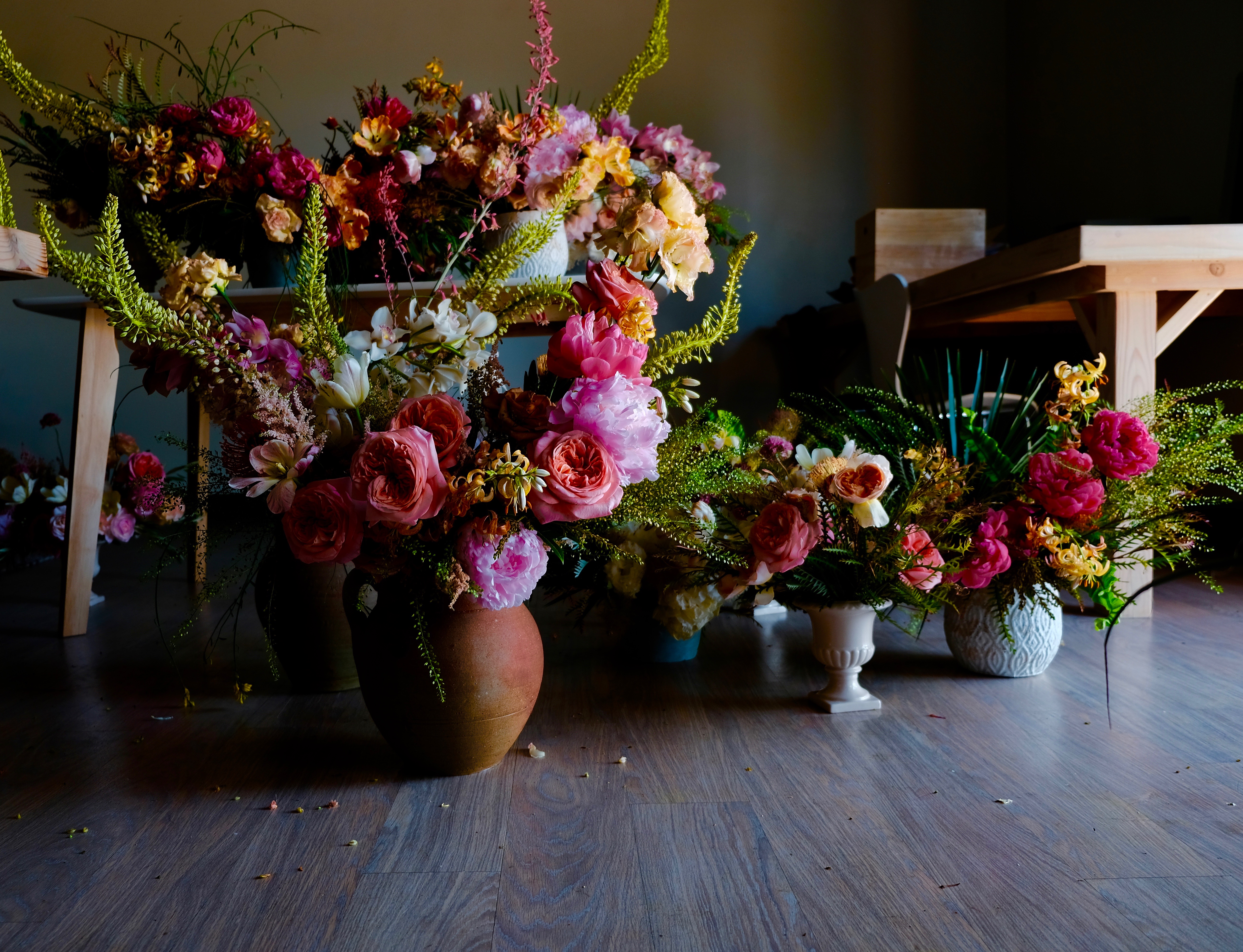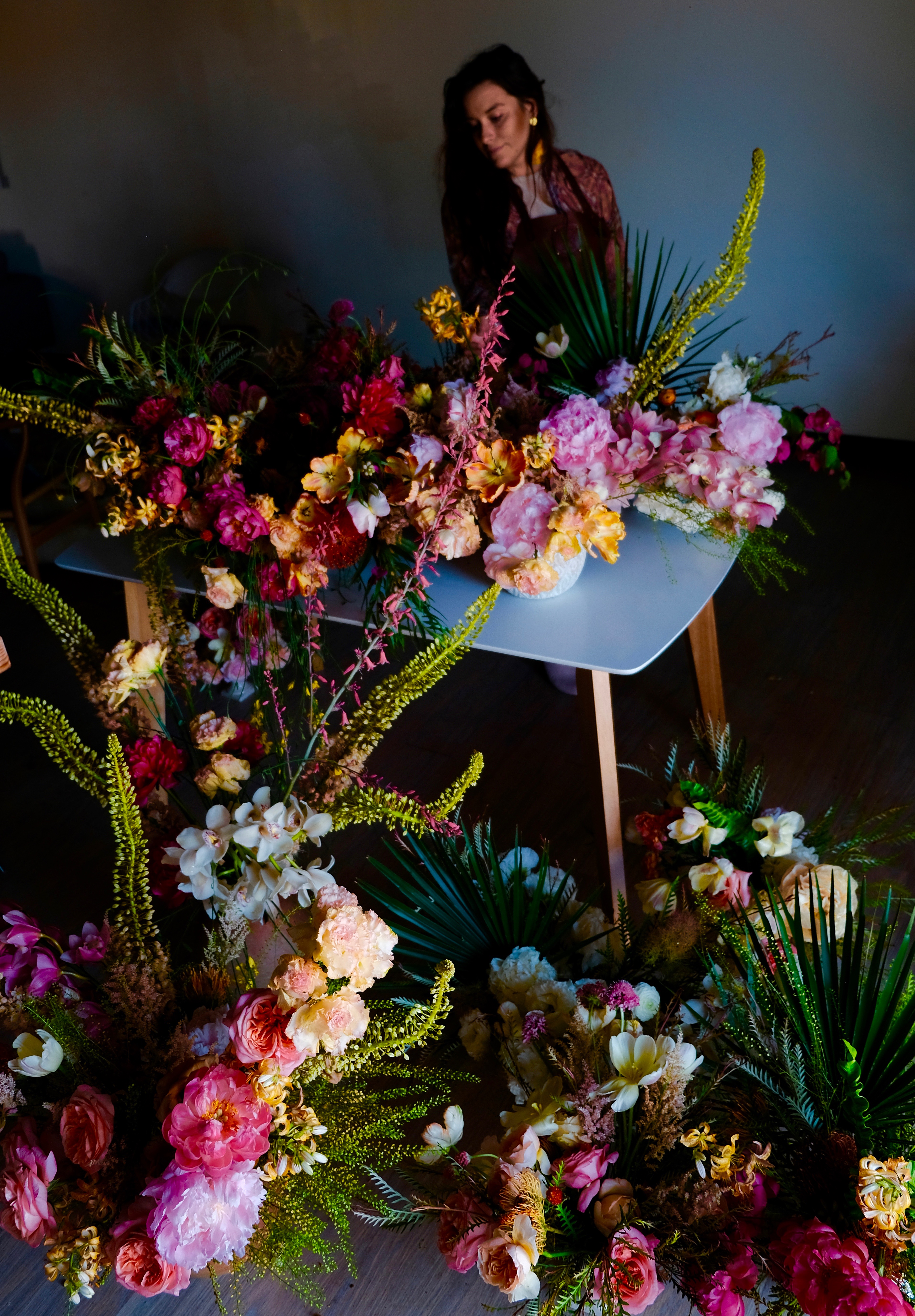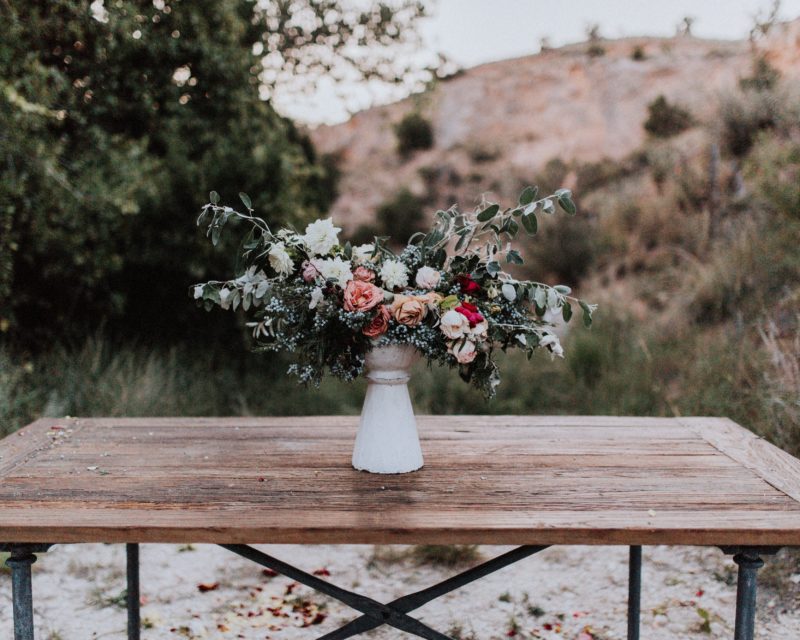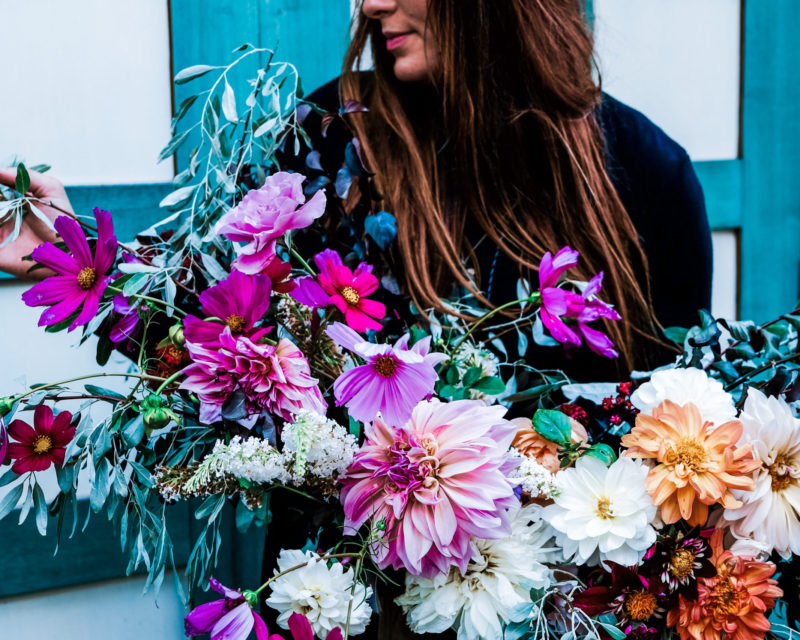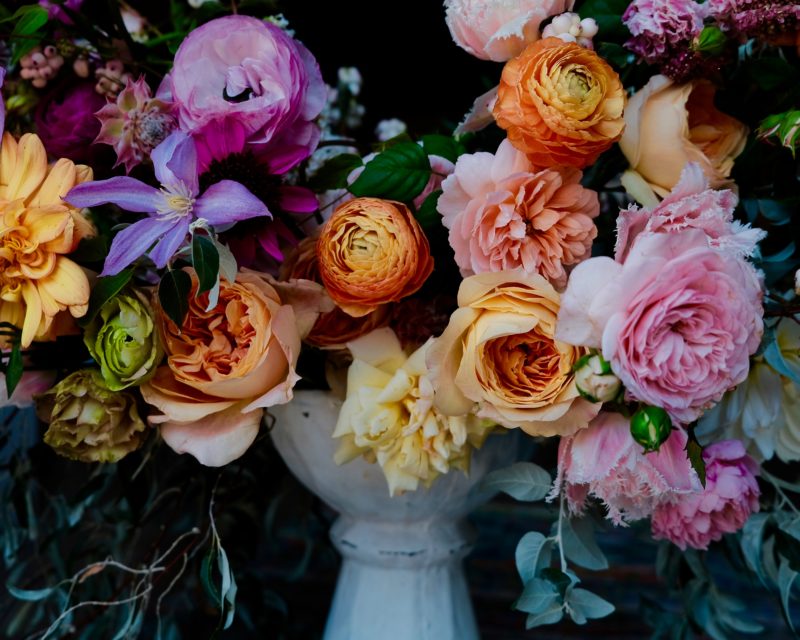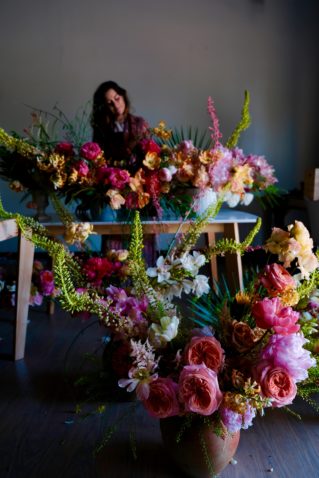
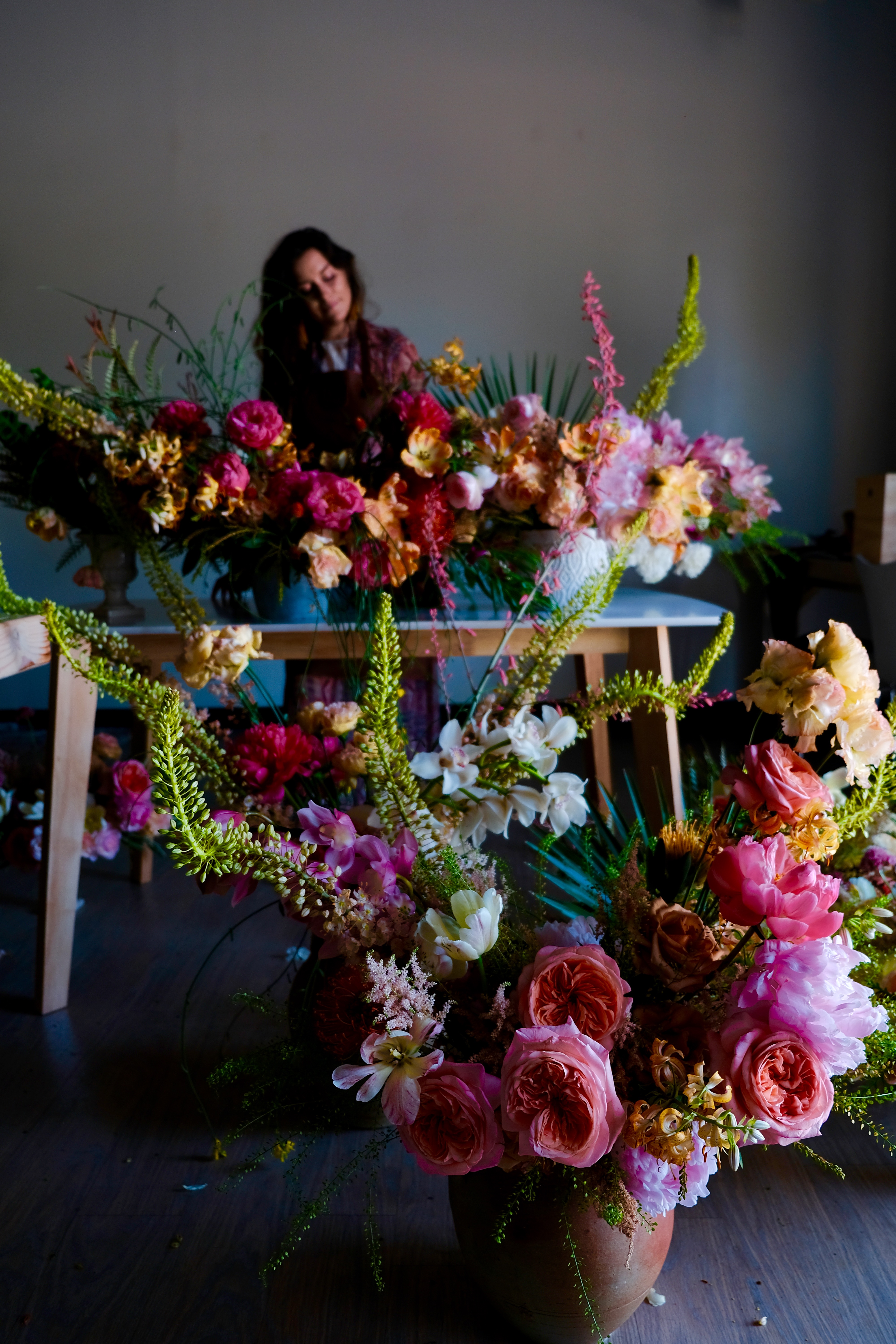
The gardens hold a special place in my memory, as my experience there marked the kind of advent of my floral career. I visited them as part of a design workshop I had signed up for; a dreamy week of arranging event-style table lays, bouquets, and installations. A magazine was there to photograph and document our work, and we would arrange on the property, in a white wedding tent. Masses of flowers were there, waiting in buckets, for us to work with, and we could choose whichever blooms we liked. All slightly unreal.
When I arrived in Santa Barbara, I was staggered by its beauty—miles of coastline, luminescent with pink sunsets. The day before the workshop began, I spent an intensely prayerful afternoon at Mission Santa Barbara, where I walked through the rose gardens, and prayed about my new career and calling. From there, a trip to the ocean, where I could do nothing but walk and reflect on the exquisite beauty of creation. It all felt too beautiful to be true.
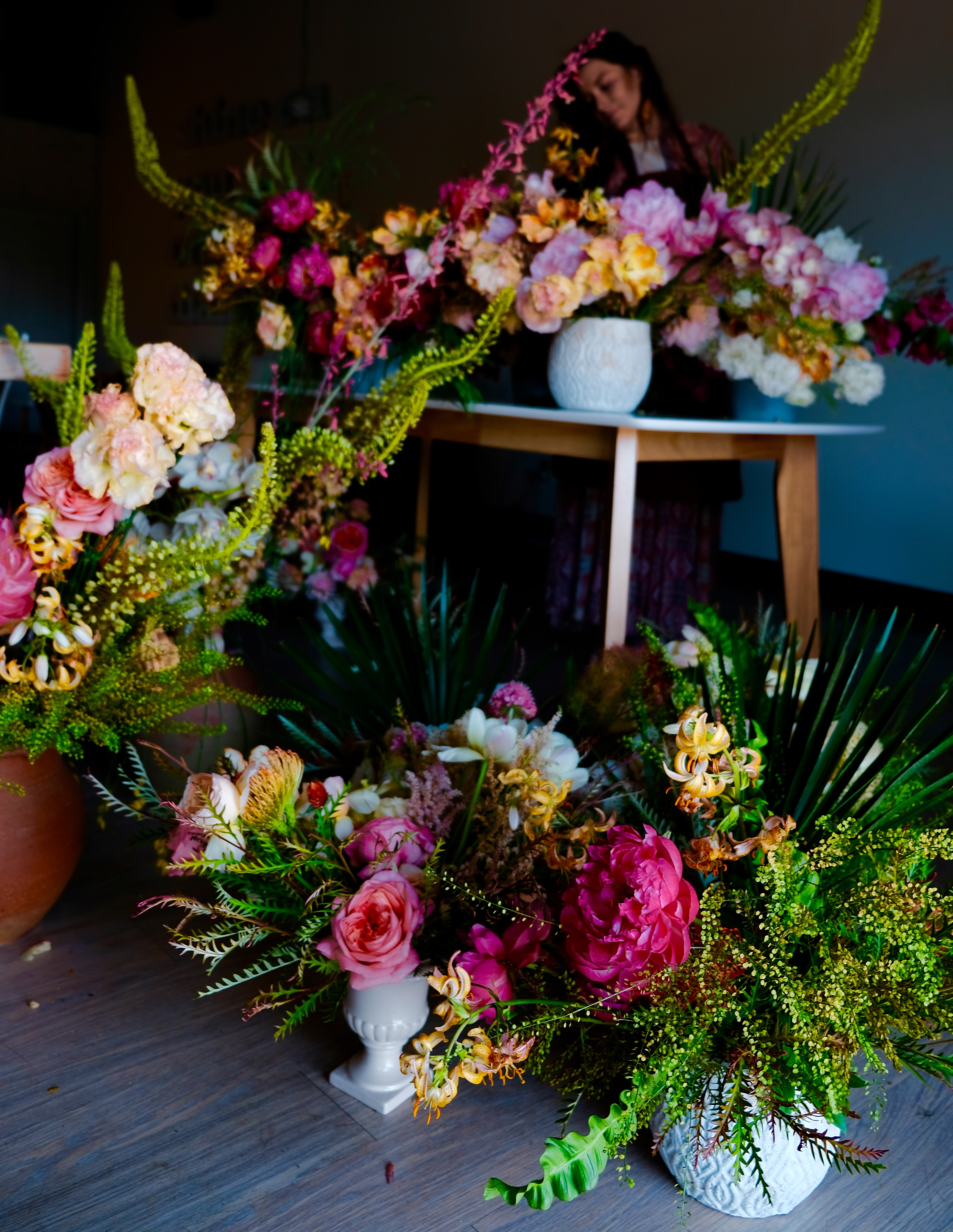 But for all the sense of blessing and excitement, I was harboring so much fear. I was, at that point, brand new to my floral career, and terrifyingly insecure. Deep within, I knew I felt called to pursue floral design—that one day, even, I would be good at it. But my skills had not yet matched up with my sense of calling. I felt ashamed to be seen at this early stage of creativity; my standards were higher than anything I could yet produce. I found some reassurance in the knowledge that I had done this before—that I had relocated to pursue skating, without having had any prior formal training. That I had submitted bad, early drafts, in the service of learning to write well. Creating bad things is an inevitable and necessary, if unpleasant, part of the artistic process. When it came to my flower career, I would just have to create more. Maybe then, after giving myself over to the practice, day after day, I would find something like mastery, and artistry, and an expression all my own.
But for all the sense of blessing and excitement, I was harboring so much fear. I was, at that point, brand new to my floral career, and terrifyingly insecure. Deep within, I knew I felt called to pursue floral design—that one day, even, I would be good at it. But my skills had not yet matched up with my sense of calling. I felt ashamed to be seen at this early stage of creativity; my standards were higher than anything I could yet produce. I found some reassurance in the knowledge that I had done this before—that I had relocated to pursue skating, without having had any prior formal training. That I had submitted bad, early drafts, in the service of learning to write well. Creating bad things is an inevitable and necessary, if unpleasant, part of the artistic process. When it came to my flower career, I would just have to create more. Maybe then, after giving myself over to the practice, day after day, I would find something like mastery, and artistry, and an expression all my own.
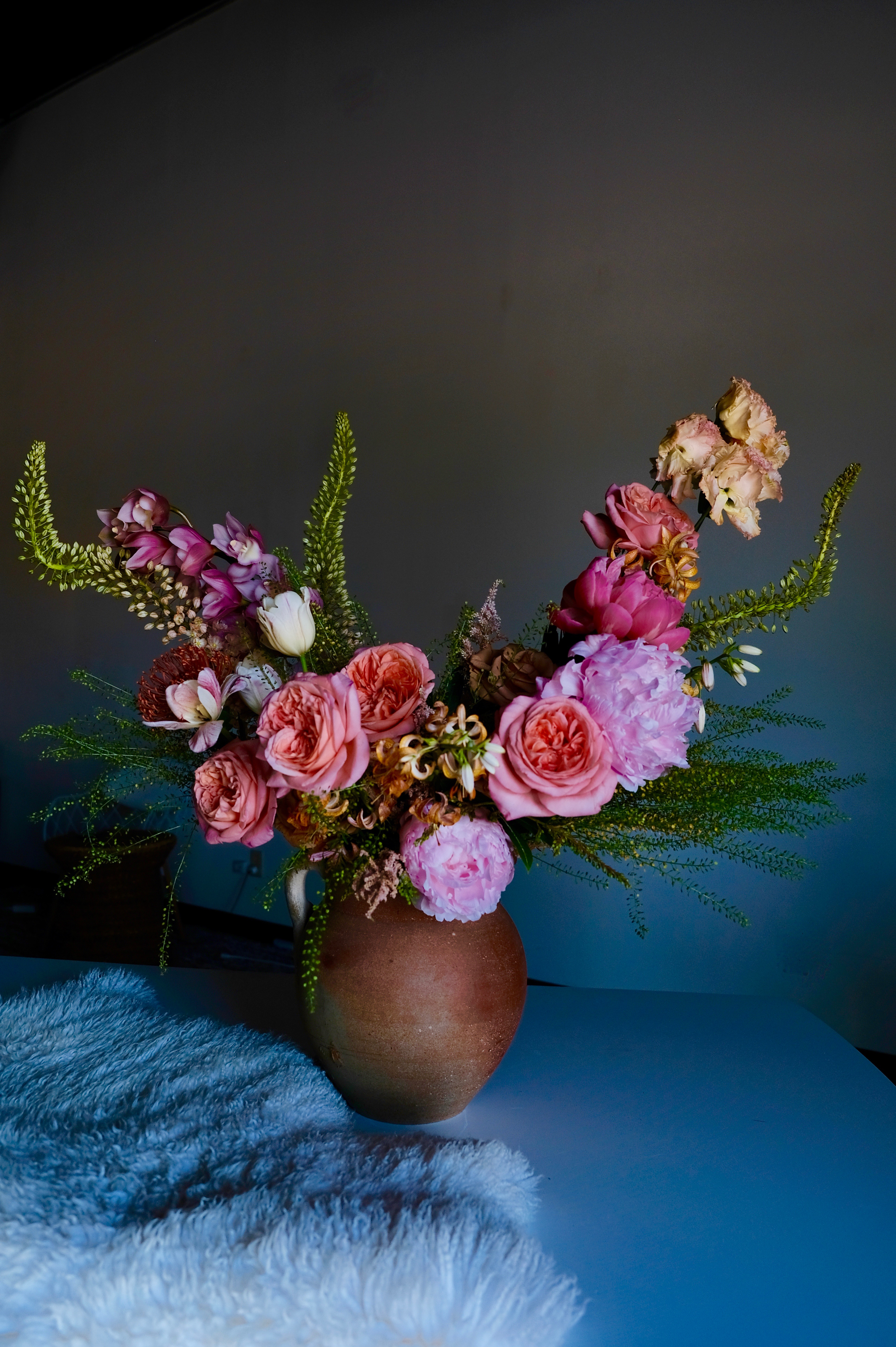
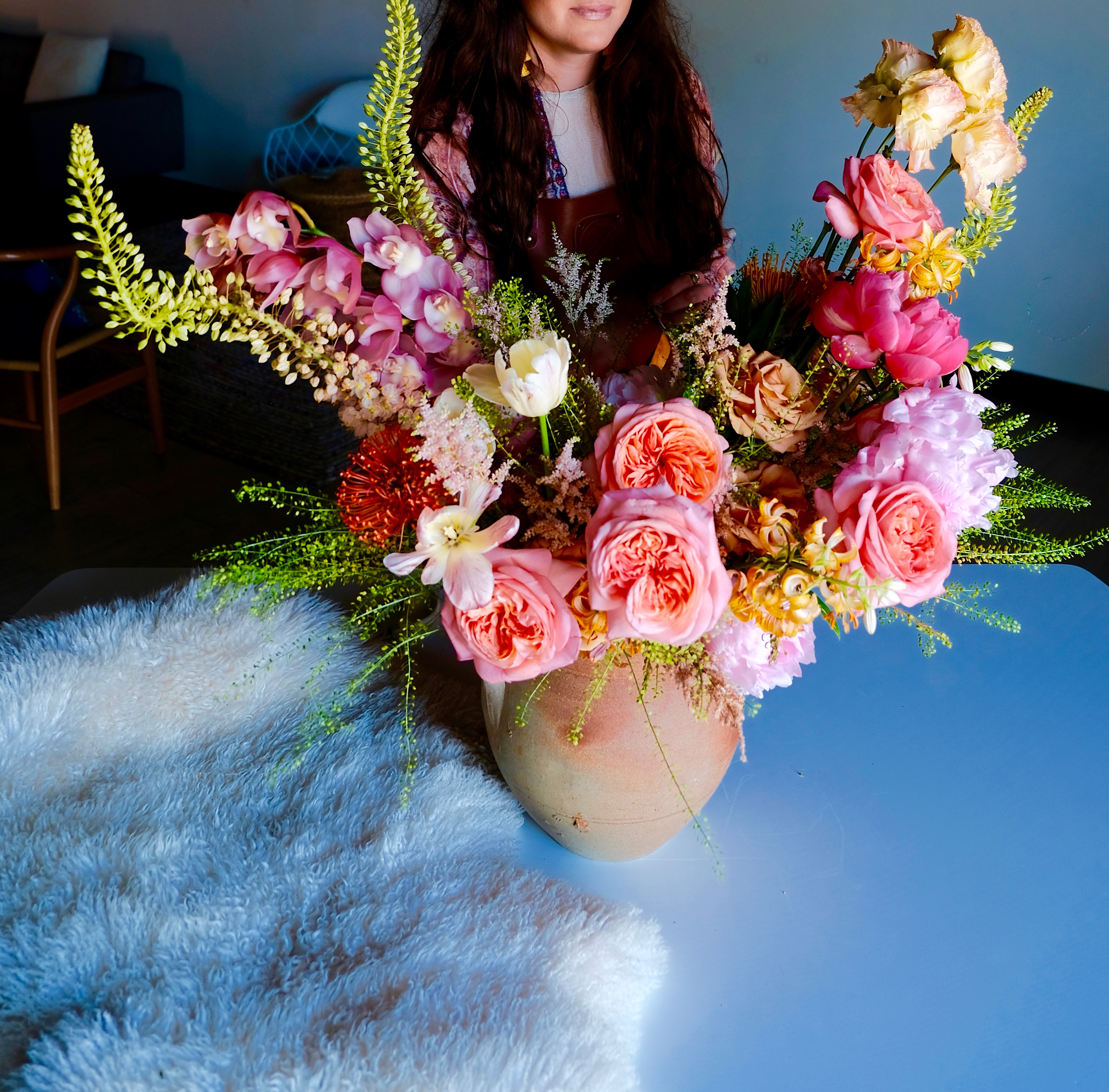
All of this would have been well and good, had I not been surrounded, at the workshop, by my flower heroes. I can vividly remember how I felt on the morning of the workshop—how, on the drive to there, I began to read a handout from my welcome bag. I found my name printed next to a designer whose work had inspired me to pursue my career. Far from celebrating over this piece of news, I felt despondent, and afraid. As we pulled up to Florabundance HQ, I saw Amy Merrick standing outside, wearing a camel colored Audrey Hepburn skirt and striped shirt. Amy Osaba and her assistant were there also, going over the day’s notes. A group of professional- looking (was it me, or did they just exude expertise?) women buzzed about with paper cups of coffee and cellphones. I promptly burst into tears. I was so out of my depth. I didn’t want to go in.
But, to my credit, I did—and I avoided emotional breakdown. For all of my overwrought ways, I have to give myself this: I have always done things before I am ready. And this is good, because ‘readiness’ is an illusion; it never really comes. Better to create through the doubts; only then will clarity, and eventually mastery, come.
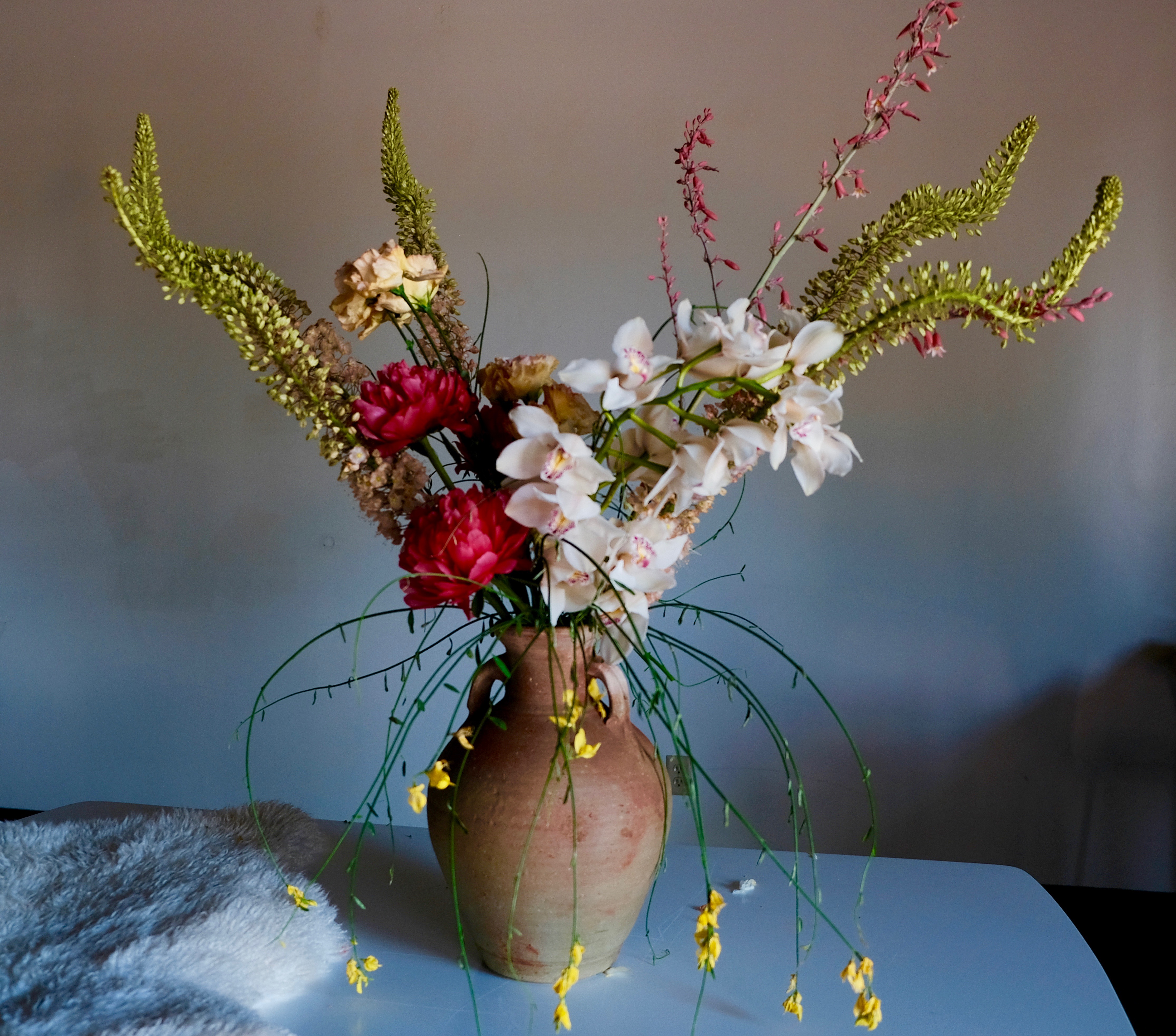
The blessed thing is that, in every season, we’ll be given some gift, some grace that keeps us going. The great gift of this particular experience was Lotusland. When I arrived at the gardens, I was overcome in the presence of nature and beauty. I felt wonder and curiosity, and I felt alive; these feelings transcended my fears. The joy was in simply being there. Any feelings of expertise tend to wither in the presence of grand nature. We realize that we are, all of us, small but significant.
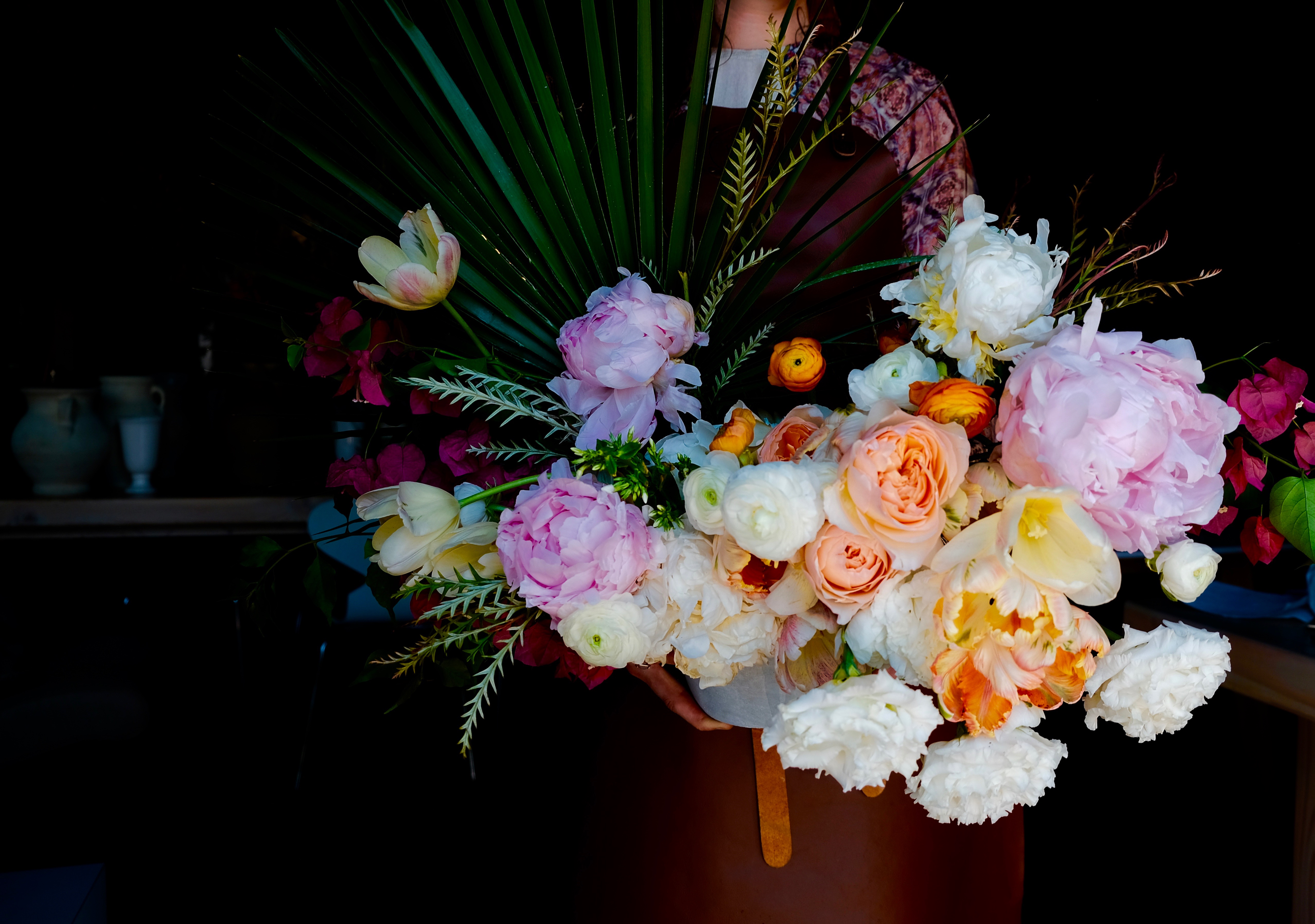 As I walked through the gardens, I felt challenged by the sheer botanical genius of it all. And I also felt transported, in the way that I have always been carried away by art, literature, and beauty. I was, after all, no stranger to the realm of the imagination—I knew how it felt to be moved deeply by beauty, and to respond with a desire to create. I had always been in the process of becoming an artist.
As I walked through the gardens, I felt challenged by the sheer botanical genius of it all. And I also felt transported, in the way that I have always been carried away by art, literature, and beauty. I was, after all, no stranger to the realm of the imagination—I knew how it felt to be moved deeply by beauty, and to respond with a desire to create. I had always been in the process of becoming an artist.
This particular part of the process was beautiful. Throughout the week, we toured the gardens, and made arrangements from some of the most exquisite flowers in the world. We laid tables with citrus and candles, and did a California take on Dutch Masters style arrangements. We cut down huge branches, and made large-scale pieces on the porch of the property. We took photos of our arrangements near the parterre, and the many gorgeous fountains. And each day, we ate our lunches on the steps of the estate’s hacienda, and shared stories and the struggles and joys of floristry. When evening came, we rode the bus home, each of us with huge bouquets in our laps— a hilarious sight. Flower school buses are undoubtedly the prettiest kind of transportation.
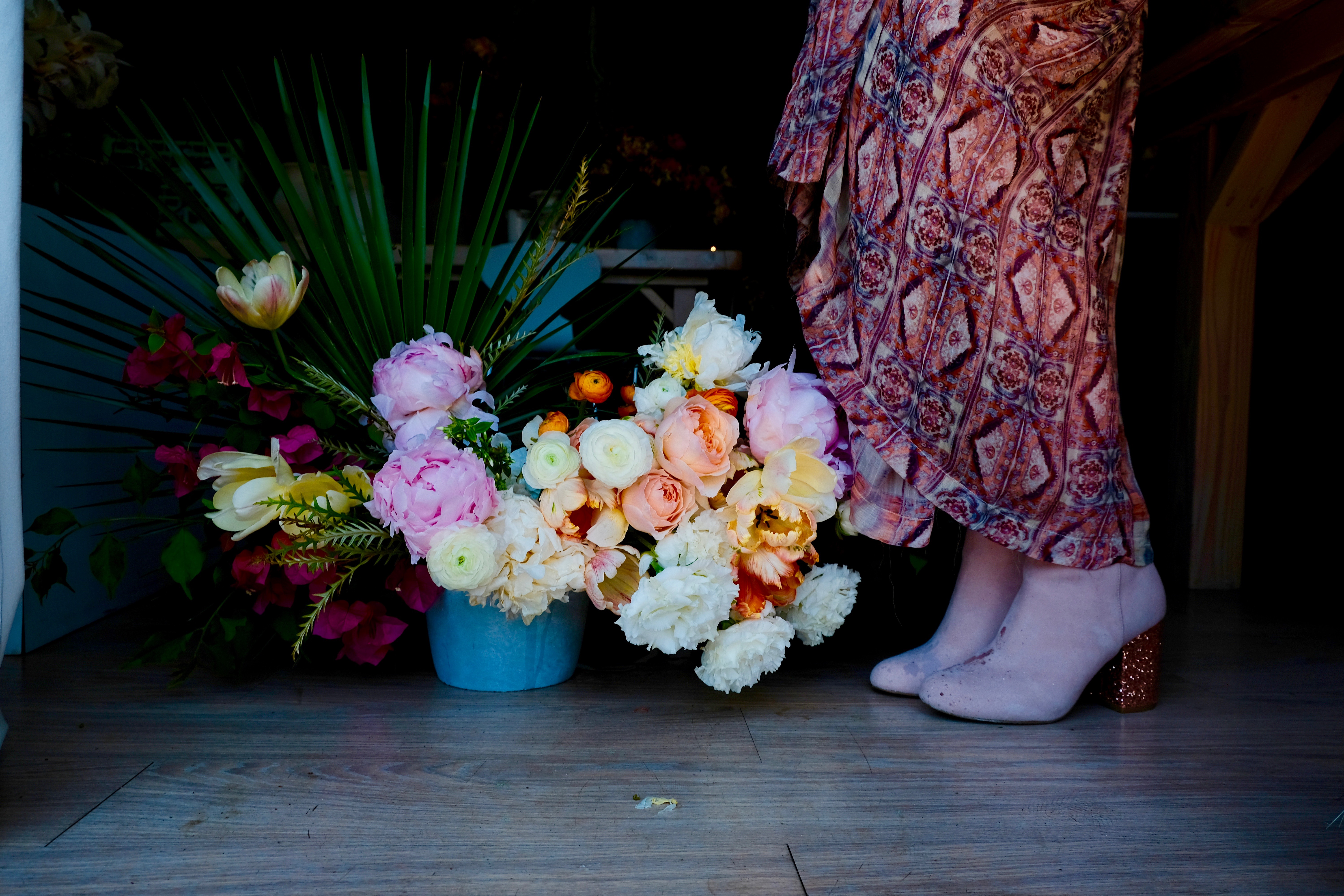
I’d like to say that I didn’t struggle that week, but I did—I struggled to complete arrangements on time for pictures, and I struggled to make things that I liked. I had small moments of triumph, and I learned a great deal. I felt inspired, and sometimes flustered and afraid. But the process of becoming an artist (much less a fully actualized human being) is hardly seamless. And to this day, I am so grateful that Lotusland is in my memory bank—that I have it to draw from when I create and envision new possibilities with plants.
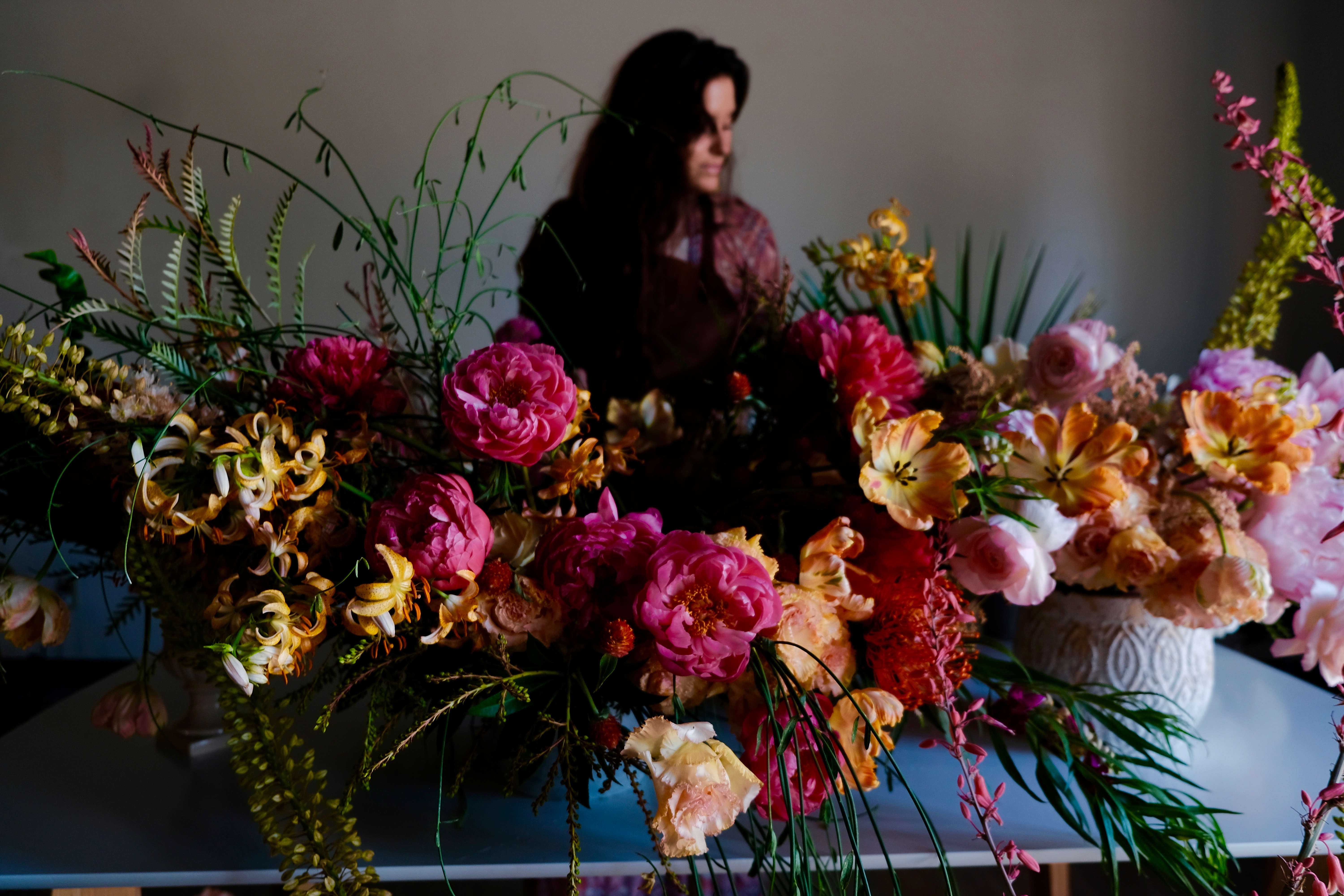

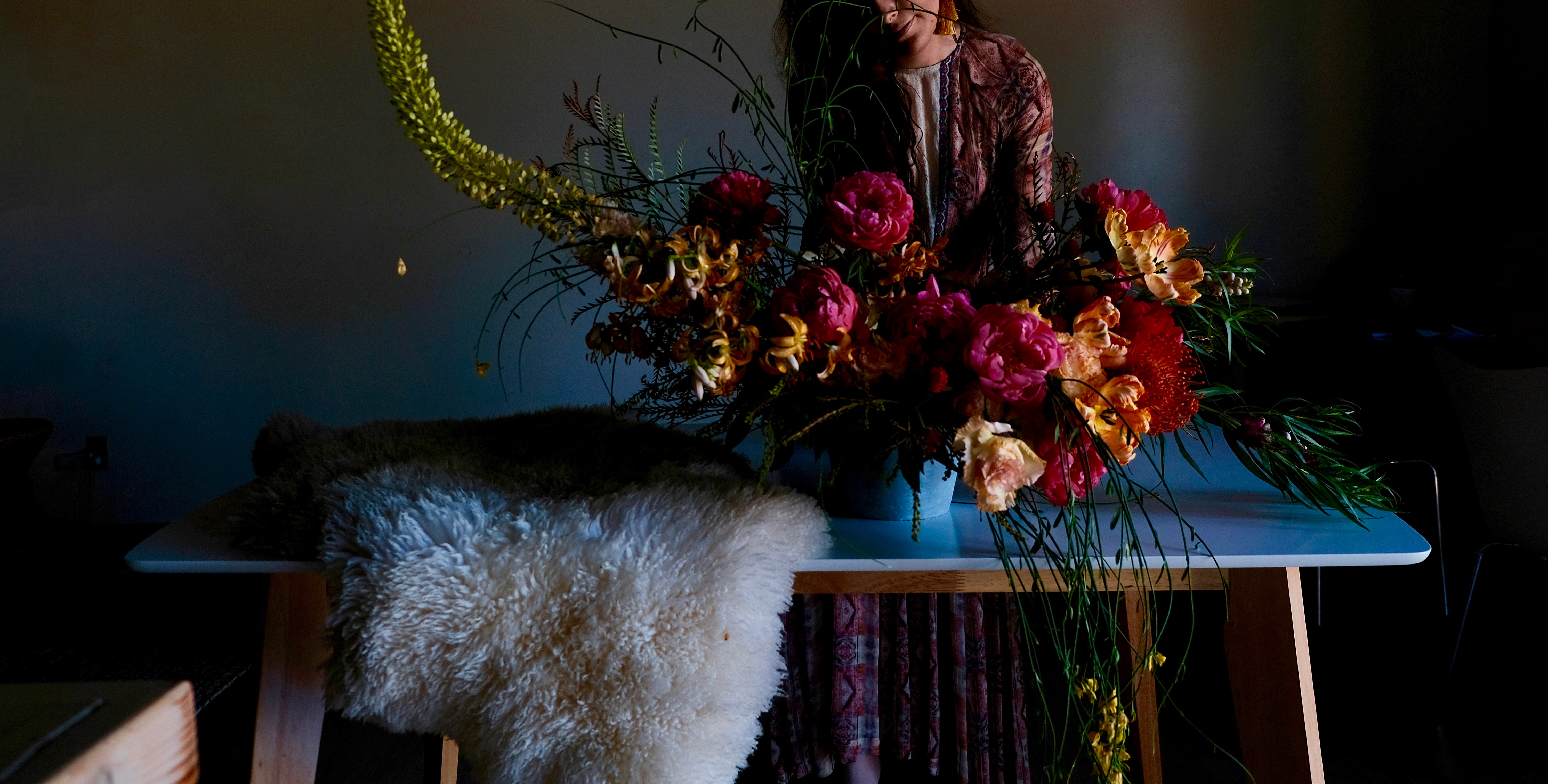
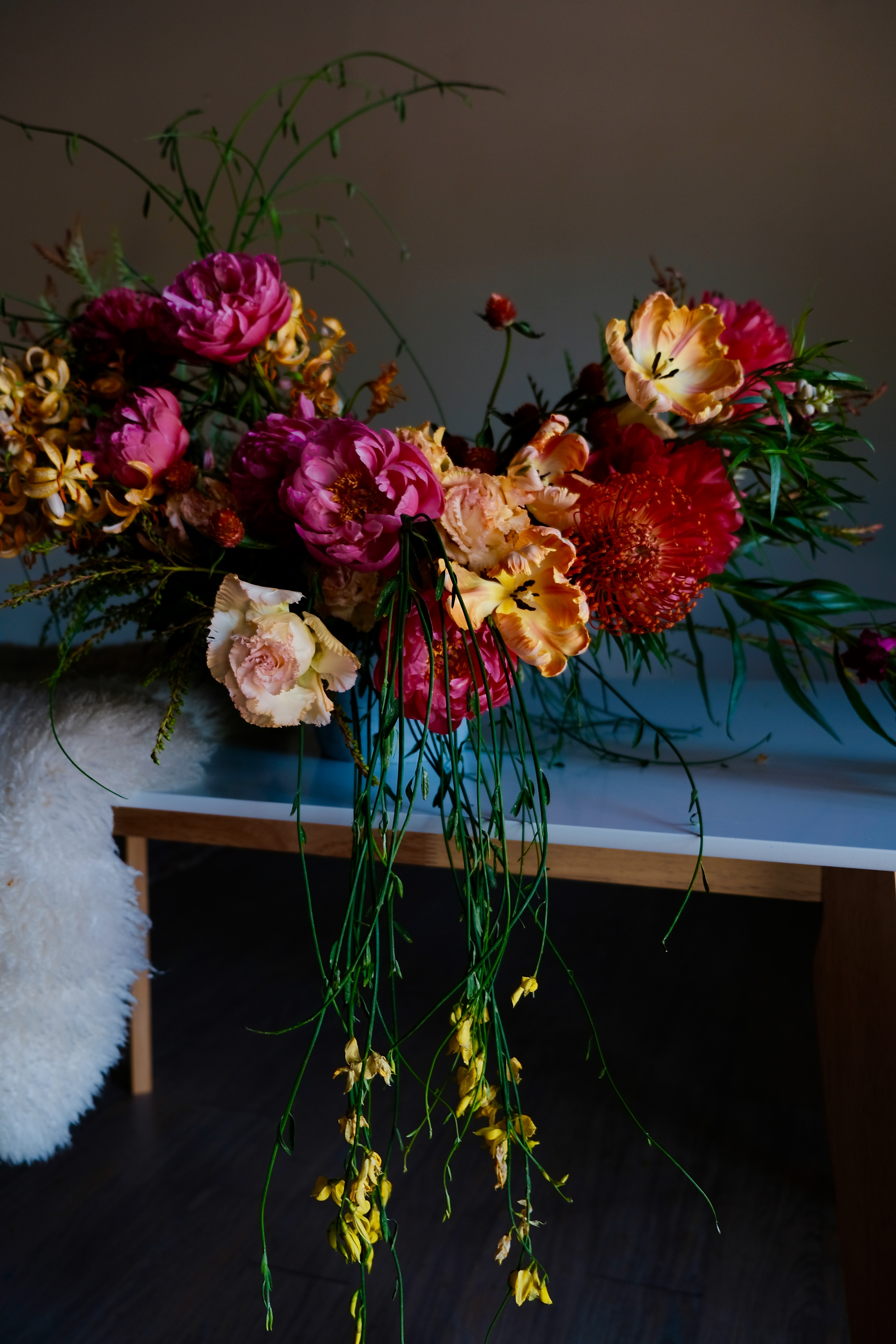
I feel I have to shift the story from my own personal experience, and dwell for a moment on the gardens, which are so rich in beauty and history and intrigue. So here, the story of Lotusland, as I know it.
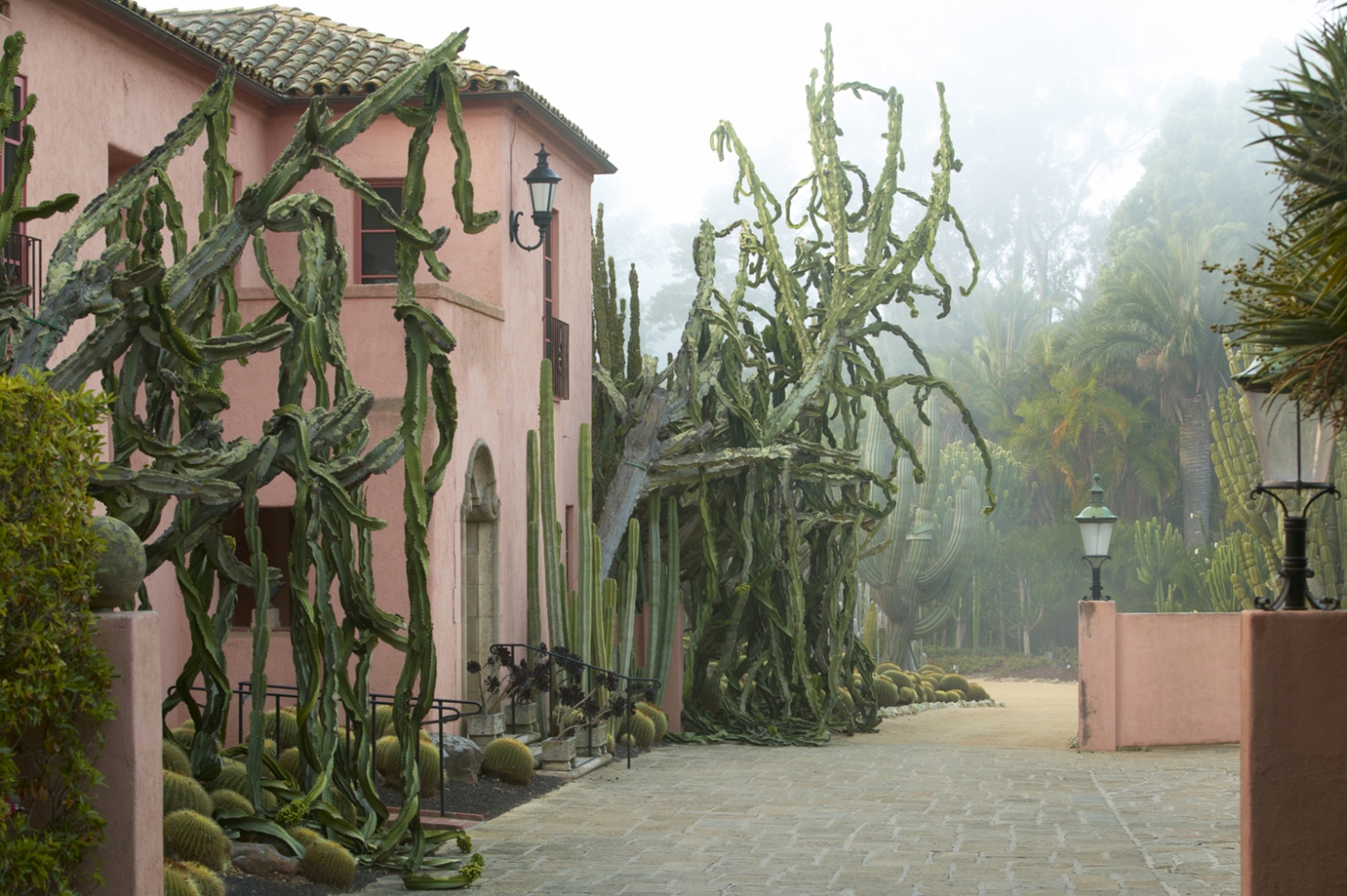
Dreamscapes: Inspiration and Beauty in Gardens Near and Far. Cited from Gardenista, “Letter From California: Lotusland Survives Fire and Fury in Montecito.”
Much of the fascination with Lotusland, as abovementioned, has to do with its most vivacious owner, the Polish Opera singer Madame Ganna Walksa. When taking a garden tour or reading about Lotusland, you will inevitably hear about Walksa’s colorful past—her touring days as an opera singer; her reputation as a socialite; her six husbands. You will hear about her notoriety, her beauty, her various quests for artistic and spiritual enlightenment. At some point, Walska began to tire of touring life, and settled on California for her next chapter. A marriage would follow, to a much-younger yoga teacher (very ‘60’s), at whose urging she bought the property that would become Lotusland. The pair flirted with the idea of ‘Tibetland,’ a retreat for Buddhist monks. But the marriage wasn’t to be, and neither was Tibetland. Walska was destined to create a garden on her own terms; an oasis of beauty that totally reflected her voice and vision. She called this place ‘Lotusland,’ after the serene flowers that drift across the property’s ponds.
Walska brought her garden to life in the very way you would expect—with boldness, and passion, and joie de vivre. While she would work alongside a host of architects and famed garden designers, the role of ‘head gardener’ she reserved for herself. It was certainly the most role of a lifetime, and Walska played it with flair. Her taste for the theatrical extends to all her plant selections: crazy succulents, euphorbia, cycads, and aloe, as well as exquisite fountains, ponds, and pools. She amassed a huge collection of plants, which she grouped en masse for extra drama. Everyone will tell you that, for all her diva ways, Walksa was very much in the dirt, at the crack of dawn, ready to take the reigns of her garden. Actively involved in both the creative direction and the physical work of the garden.
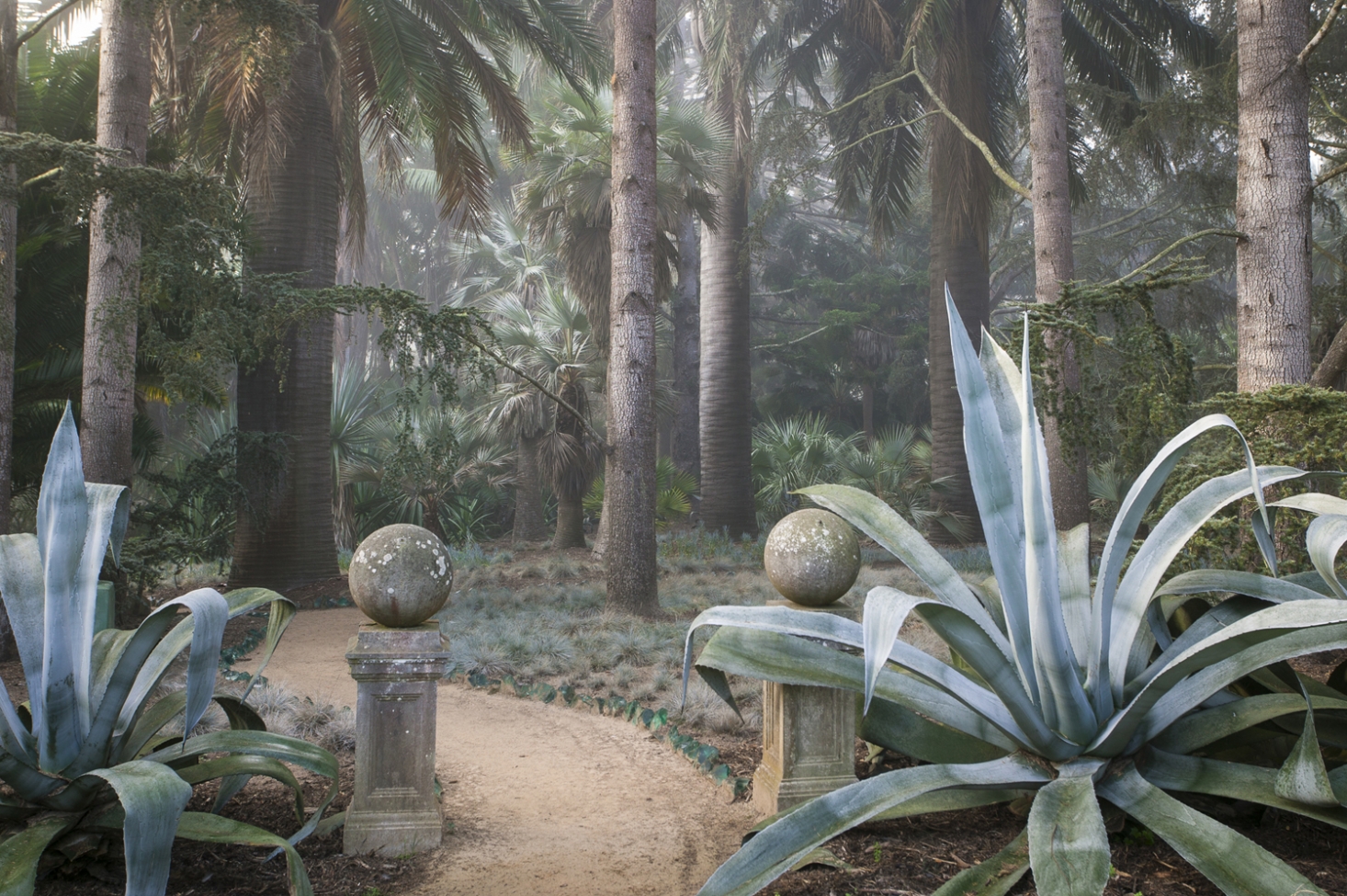
Dreamscapes: Inspiration and Beauty in Gardens Near and Far. Cited from Gardenista, “Letter From California: Lotusland Survives Fire and Fury in Montecito.”
Lotusland is a spectacle of the biggest, rarest, and best plants. It’s clear that Walska wanted to create a garden for the ages, and she succeeded. We cannot help but see her in a garden of such commanding personality, theatre, and eccentricity. It is her legacy.
Even without the colorful backstory, the gardens would be of importance. Lotusland is home to so many botanical wonders— the plants are astonishing in their own right. There is an entirely ‘blue’ garden of fescues and agave, all impressively huge. Chilean wine palms cast shadows over the Blue garden, and morning mists roll in and endow them with an intense feeling of otherworldliness. Another garden is comprised entirely of cacti, and another of cycads. Clam shells encircle the aloe garden, and a huge, clam shell fountain rests in the certain of the pool. California bestows its rich produce upon the garden, and the orchards overflow with citrus, guava, peaches, persimmons, plums.
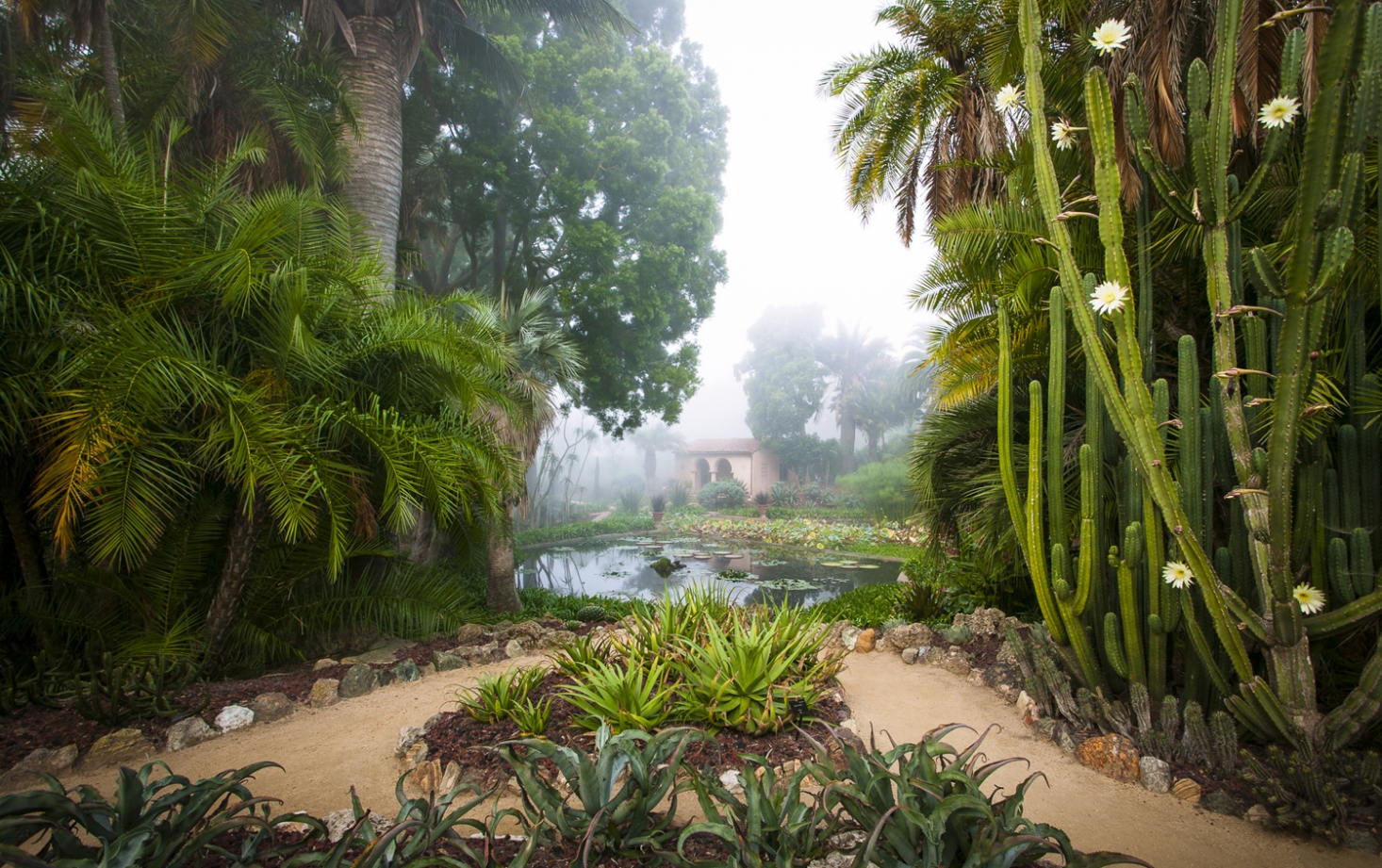
Dreamscapes: Inspiration and Beauty in Gardens Near and Far. Cited from Gardenista, “Letter From California: Lotusland Survives Fire and Fury in Montecito.”
The magnificence is hardly reserved to the plants, however, as attention has been lavished upon the hardscaping, the tile work, the many ponds and pools. Of particular interest, a cypress allée flows from the swimming pool and ends with a little limestone-hewn wishing well. At an angle to the wellhead is a magnificent series of water stairs, which feed into a Japanese style garden.
And then there is the pink, Spanish-style hacienda at the heart of all of this. The walk up to home is choreographed to elicit a response; the driveway is lined with golden barrel cacti, and the front of the home seems to be overtaken by enormous, spindly euphorbia. Behind the home, formal parterre in two sections: the upper overflows with floribunda roses and iris, and includes a Moorish, star-shaped fountain; a pebble mosaic and statue of Venus commands attention in the lower parterre.
The mood of these gardens—the intangible, indefinable mood—is something else. Lotusland is perhaps the most mystical, ethereal, entrancing place you could visit. I love it all: the sense of collectorship; the fearless artistry; and the rule-breaking, contrarian spirit that runs throughout the gardens.
When it came to channeling Lotusland through my arrangements, I wanted to keep intact the strangeness, the spirit, the precision, and the impracticality of the gardens. There had to be huge, creaturely looking plants and palms. It was important to experiment with scale and shape, and achieve height and drama. The color palette needed to be particularly evocative, and to create it, I gathered all the parts of Lotusland that I love—shades of the pink hacienda, the creamy white of a clam shell, the Italian tiles, the gray-blue agaves, and cactus greens. Terra-cotta and clay vessels felt reminiscent of Spanish adobe, and gave the palette a very California feeling.
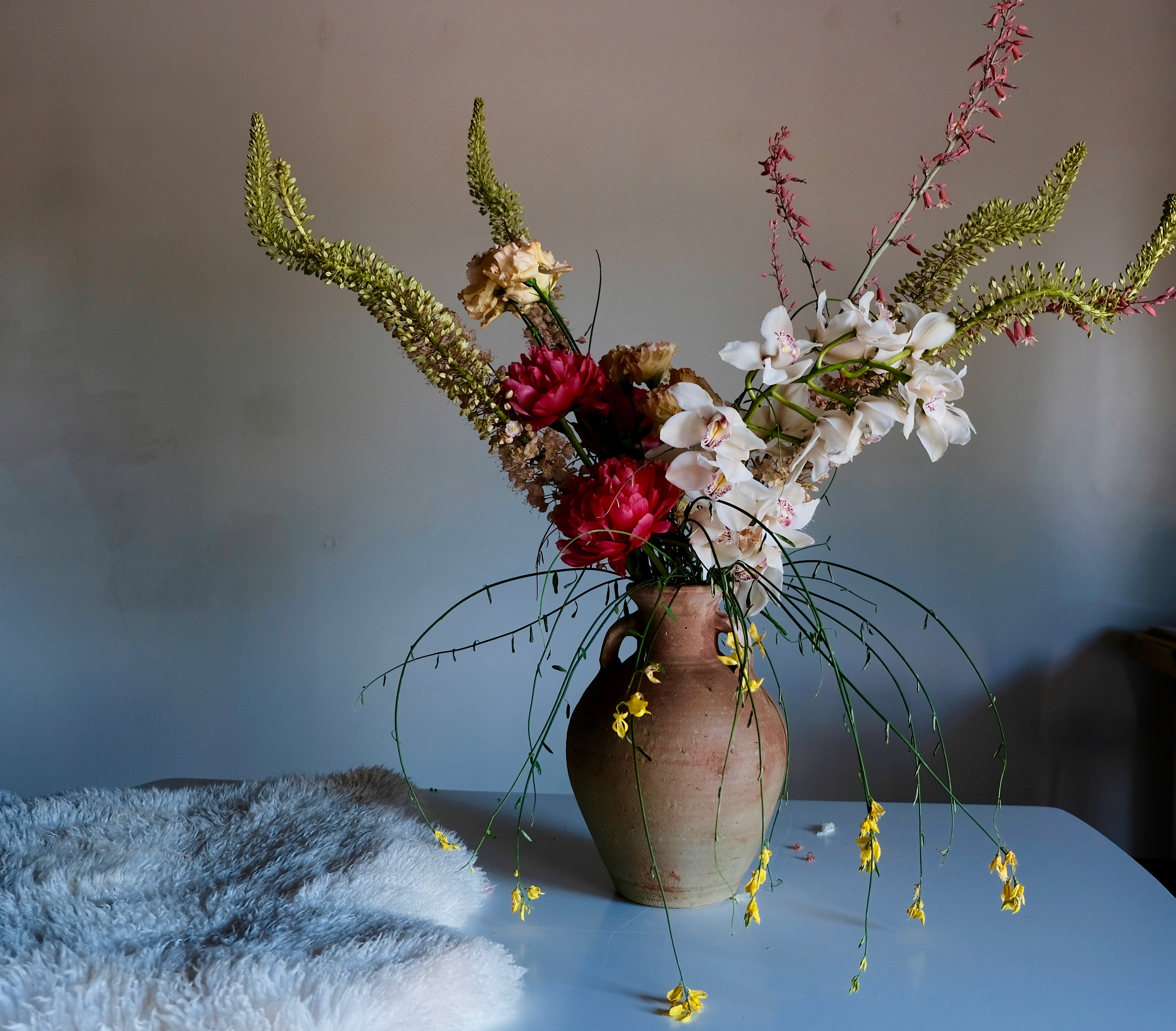
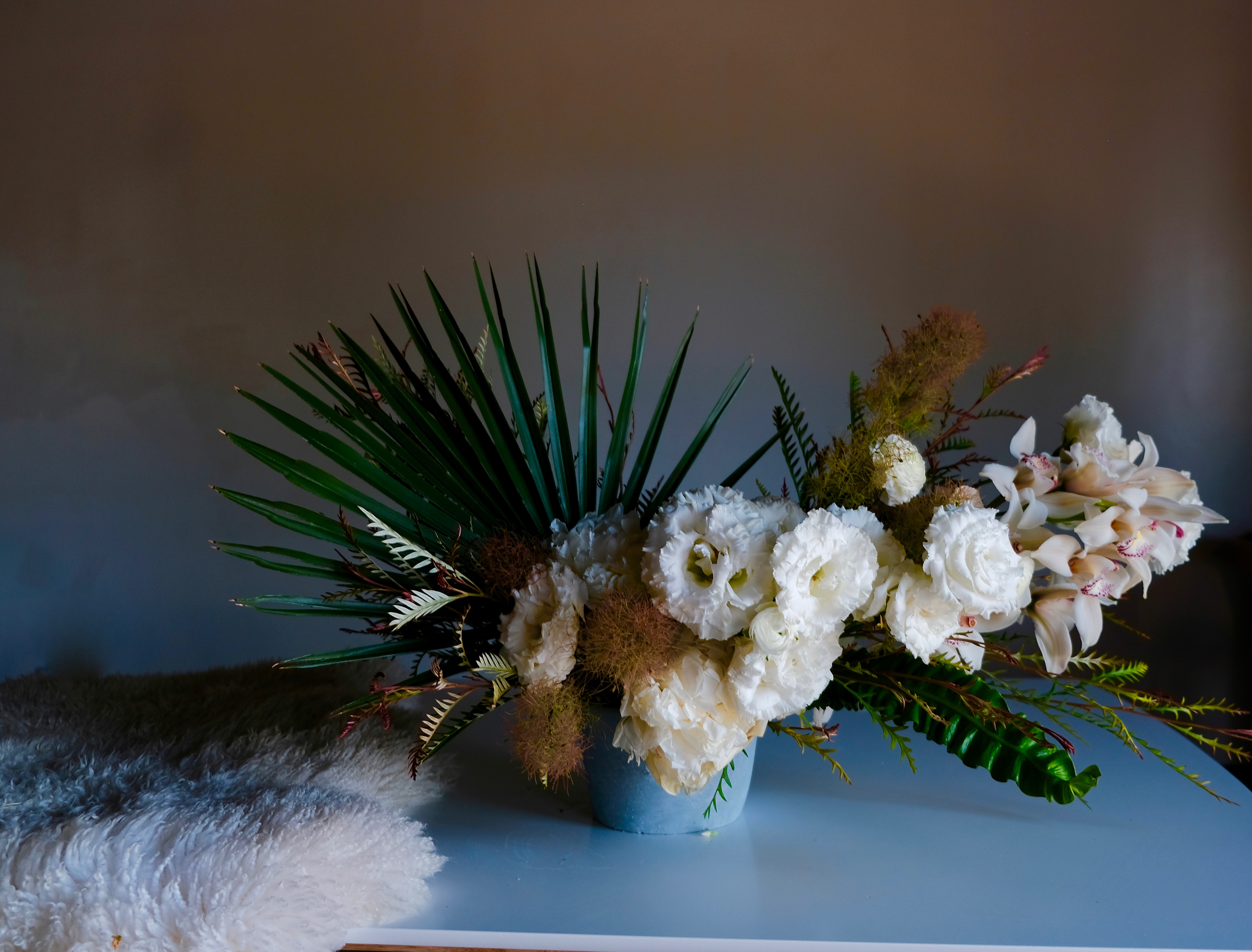
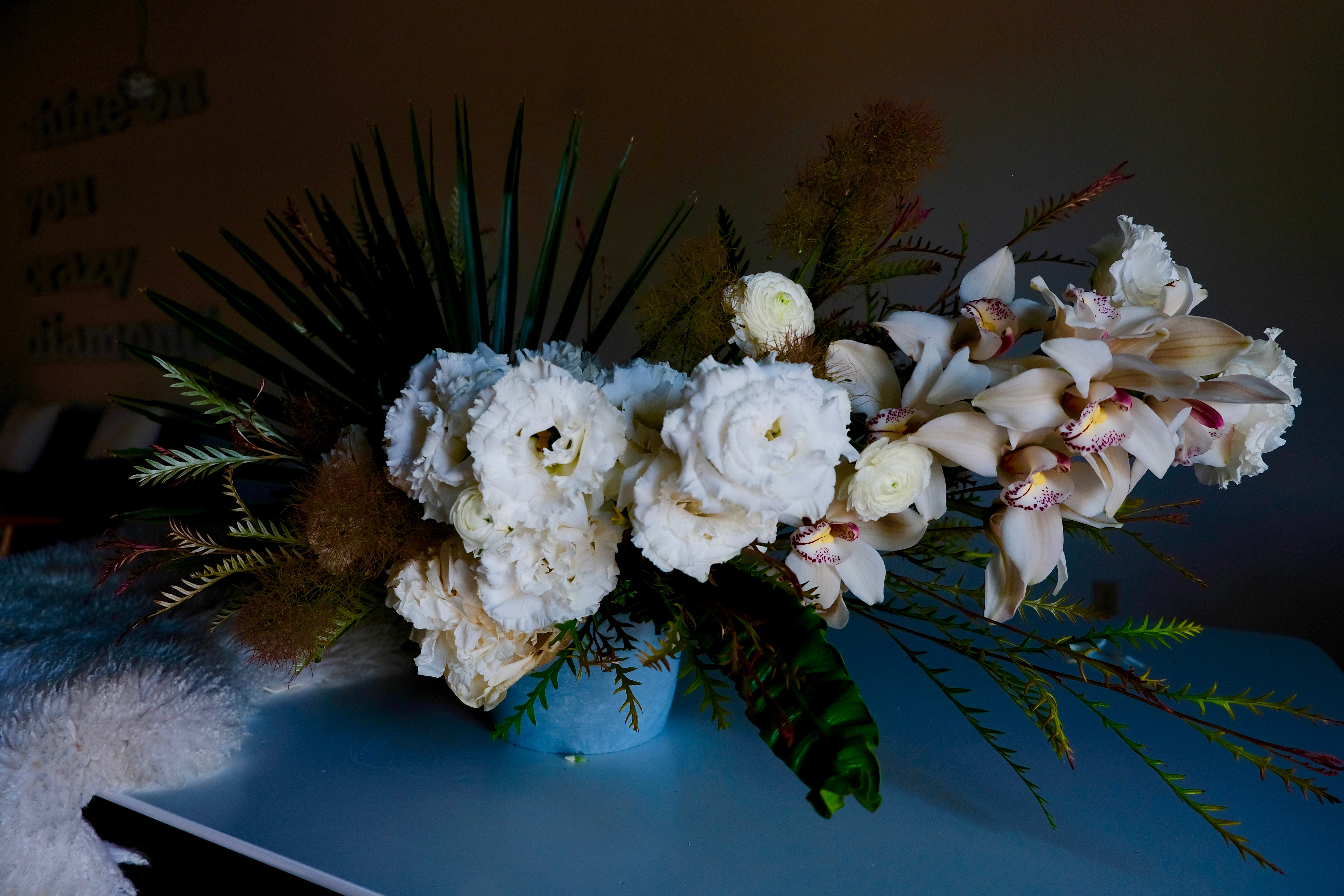
And then there were the plants themselves—huge eremerus, succulent flora, and desert-thriving things, along with more feminine, summer blooms. Japanese lisianthus felt rare and exquisite (the kind of thing Walska would love in a cut flower arrangement), and lent the palette a perfect, apricot-tinged neutral. There were rare lilies and trailing bougainvillea. Showy cymbidium orchids, and foraged Spanish broom pieces, spilling over the lips of vases. Orange and apricot pincushion protea felt reminiscent of those Montecito sunsets—glowing and pink-tinged and filled with near-invisible traces of the reflected coastline. Marrakech pinks, hot magenta hues, and yellows created a tapestry of colors. There is no way to recreate or replicate Lotusland (and I’m not interested in straightforward recreation, ever). Hopefully the end result simply felt as thought-provoking, as slightly surreal, and as dramatic as a tribute to Lotusland should.
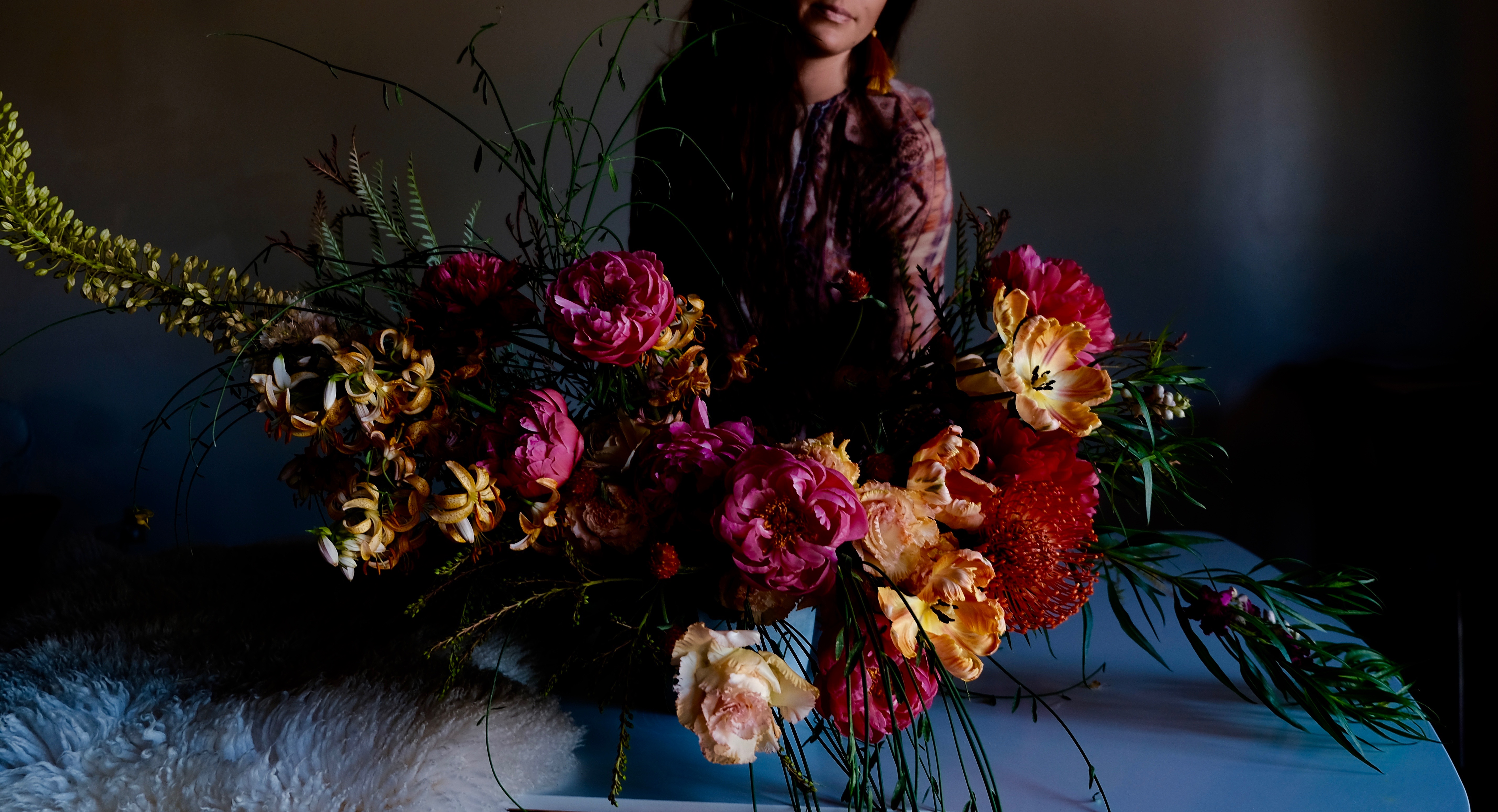
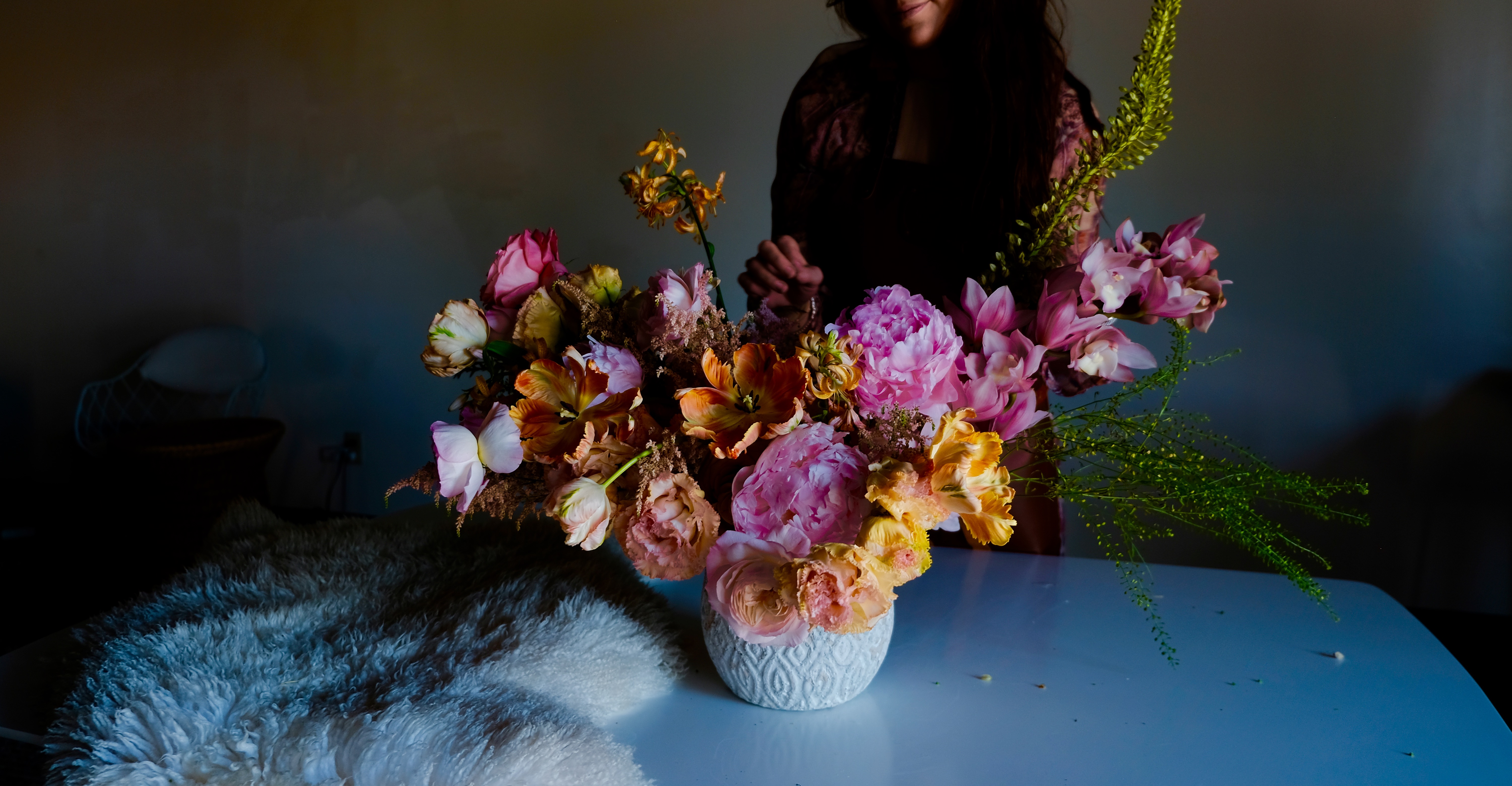
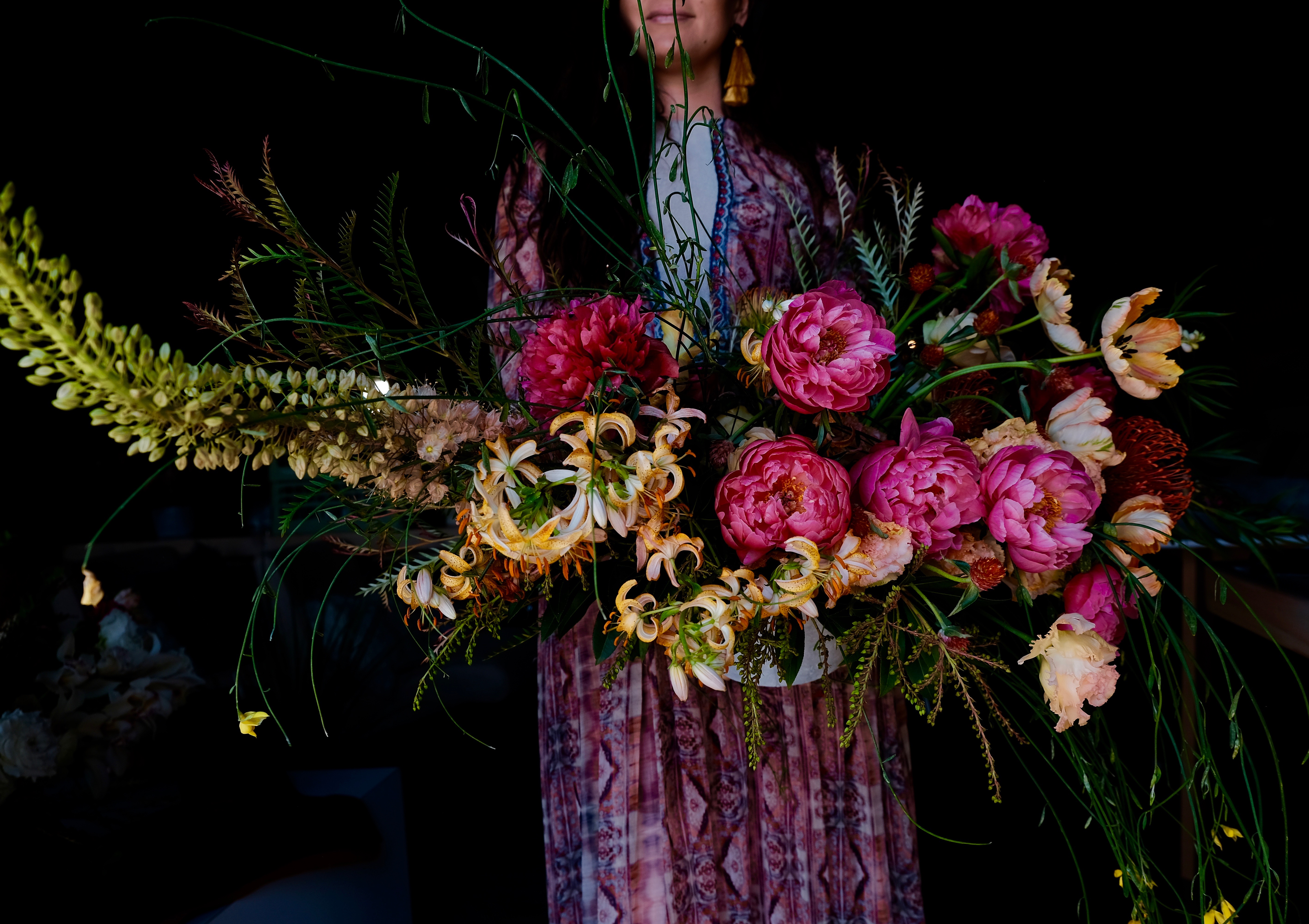
A conversation about Lotusland is timely, as we’ve witnessed such destruction in and around Montecito recently. It is my prayer that this beautiful land remains untouched by natural disaster, that those who have been affected would see their lives and land redeemed and rebuilt in ways they didn’t imagine possible. And it is my hope that these the gardens remain intact, an oasis and an inspiration to current and future generations.
Please visit the Lotusland website for more information on this incredibly creative garden, its history, and mission.


